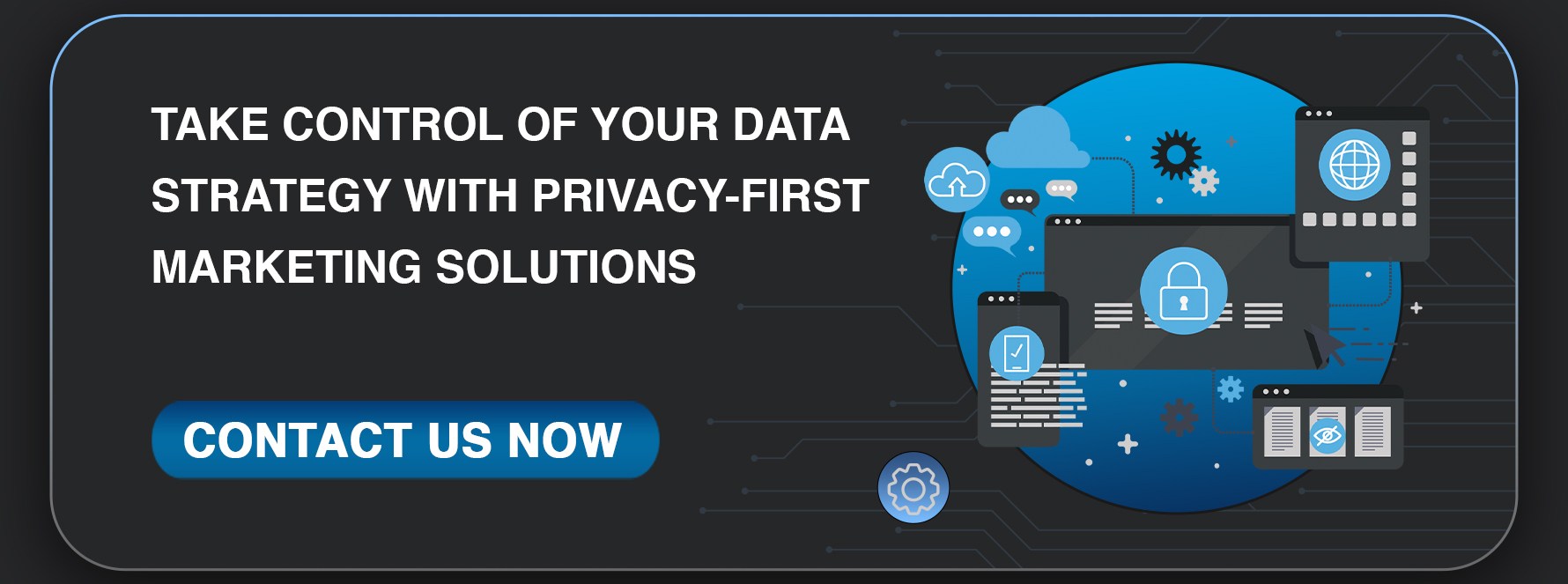In an age where consumer data powers nearly every digital interaction, privacy-first marketing has emerged as a core strategy for brands looking to build trust, improve engagement, and comply with evolving data regulations. Businesses are being held to a higher ethical standard as worries over the collection, usage, and sharing of personal data grow. Trust can no longer be treated as a byproduct of good service; it must be a foundational element of your data-driven marketing approach.
As third-party cookies fade into obsolescence and global regulations tighten (like GDPR and CCPA compliance), companies must now lean on transparent, ethical data practices that prioritize first-party data and customer consent. This transition not only protects users’ privacy but also strengthens the bond between brand and consumer.
In this blog, we’ll explore what first-party data is, how it differs from other types of data, and how brands can develop a winning first-party data strategy, all while staying compliant and competitive in a cookieless world.
What is First-Party Data?

It’s critical to ask: What is first-party data in order to appreciate its value? It refers to information collected directly from customers through interactions on a brand’s platforms. Unlike third-party data, which comes from external sources and lacks direct customer engagement, first-party data is both highly accurate and consent-based, making it essential for marketers who want to personalize user experiences while respecting privacy boundaries. Key sources of first-party data include:
Website interactions
Tracking how users navigate your website, such as page views, clicks, and form submissions, helps you understand their interests and behavior. This knowledge is crucial for enhancing the user journey and optimizing content.
App usage
Monitoring user behavior within your mobile or web applications reveals preferences, feature engagement, and patterns. These insights help refine in-app experiences and guide push notifications and personalized offers.
Purchase history
Analyzing what customers buy, how often, and in what combinations gives you a clear view of their shopping habits. This enables personalized product recommendations, special offers, and loyalty programs tailored to individual preferences.
Email subscriptions
When users sign up for newsletters or promotional emails, they provide contact details and communication preferences. This allows for targeted messaging and the ability to measure interest through open and click rates—insights that can also inform content shared across email and social media platforms for consistency and wider reach.
Customer service conversations
Interactions via live chat, phone, or email with your support team offer direct feedback on customer pain points, questions, and satisfaction. These insights help improve service and can even inspire social media FAQs, support content, or response strategies.
CRM entries
Your Customer Relationship Management (CRM) system compiles contact information, a communication history, and behavior data in one place. This centralized view allows for detailed segmentation and personalized outreach, whether through email, direct messaging, or custom social media ad targeting.
Unlike third-party data, which is sourced from outside platforms and aggregated without direct customer interaction, first-party data is highly accurate and consent-based. This makes it invaluable for marketers aiming to personalize user experiences while respecting privacy boundaries.
How does first-party data differ from third-party data?
To successfully navigate contemporary marketing methods, it is essential to comprehend the distinction between first-party and third-party data:
| Feature | First-Party Data | Third-Party Data |
|---|---|---|
| Source | Collected directly from customers | Purchased or accessed from external platforms |
| Accuracy | High | Varies depending on the sourc |
| Privacy Compliance | Easier to manage under GDPR/CCPA | Higher risk of compliance issues |
| Cost | Free (owned data) | Typically paid |
| Trust Level | High (collected with consent) | Lower (customers are often unaware of the collection) |
In a cookieless world, the shift toward first-party data isn’t just ideal, it’s essential.
What Is Zero-Party Data?
Information that consumers voluntarily and proactively provide to a brand is known as zero-party data. This can include preferences, interests, purchase intentions, or feedback, typically gathered through surveys, quizzes, account settings, or direct interactions. Zero-party data is voluntarily supplied by the user, which makes it extremely accurate, dependable, and privacy-friendly in contrast to third-party data, which is gathered indirectly. For marketers, it’s a powerful way to personalize experiences while building trust and transparency with consumers.
Zero-Party Data vs First-Party Data: What’s the Real Difference?
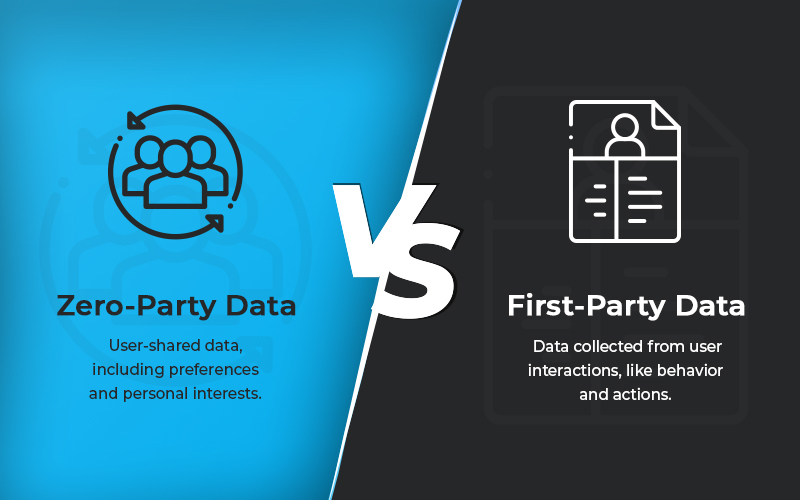
In today’s privacy-conscious digital landscape, businesses are rethinking how they collect and use customer data. Two of the most valuable types are zero-party data and first-party data, each offering unique advantages for building personalized, trust-based relationships with your audience.
Information that consumers voluntarily and proactively provide to a brand is known as zero-party data. This can include their preferences, interests, purchase intentions, or feedback, usually collected through:
- Surveys
- Polls
- Preference Centers
- Product recommendation quizzes
Unlike other data types, zero-party data isn’t inferred or observed; it’s given directly by the customer, making it more transparent and accurate. For marketers, this is incredibly powerful because it reflects what the customer wants you to know, offering a strong foundation for hyper-personalized experiences.
First-party data, on the other hand, is collected by tracking how users interact with your website, app, or emails. It includes behaviors like pages viewed, products clicked, time spent on site, and past purchases. While the user does not explicitly provide it, it reveals patterns and intent based on real-time actions.
Why Use Both?
When comparing zero-party data vs. first-party data, zero-party is often more accurate for personalization, as it tells you what a customer says they want, rather than what their behavior implies. However, relying on just one type can limit your understanding.
An ideal data-driven marketing strategy combines both:
Use zero-party data to deliver preference-based personalization, such as custom product recommendations or communication preferences.
Use first-party data to analyze behavior, predict intent, and improve the customer journey over time.
Together, they offer a more complete, respectful, and effective way to connect with your audience, especially in a world where privacy and personalization must go hand in hand.
Why First-Party Data is Crucial in a Cookieless World?
As browsers phase out third-party cookies, marketers are being forced to rethink how they gather and use customer insights. As cookies fade away, harnessing first-party data becomes crucial for creating impactful and personalized customer experiences.
Here’s why:
- Stronger Confidence: People tend to share their data more openly with brands they trust.
- Greater Flexibility: You manage what data is collected and how it’s used.
- Future-Ready: First-party data collection ensures compliance with GDPR and CCPA requirements.
- Better Targeting: Direct insights improve segmentation, messaging, and ROI.
- Reduced Risk: With tighter control comes a lower chance of data breaches and fines.
Building a First-Party Data Strategy That Works
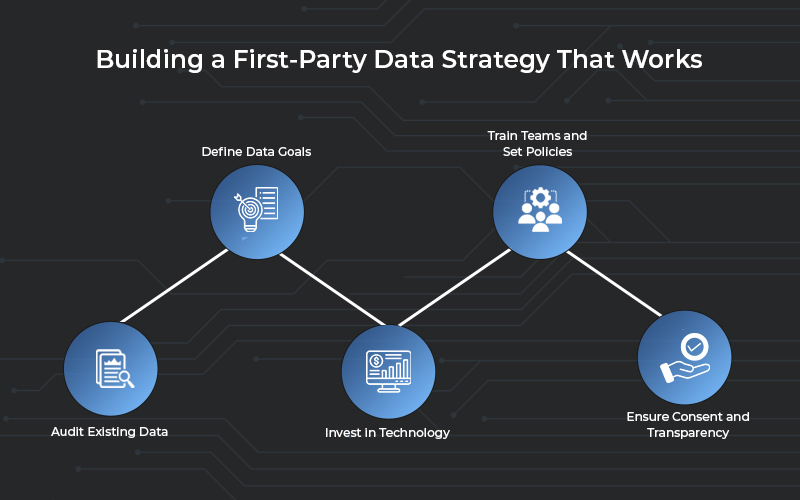
An effective first-party data strategy goes beyond basic collection. It’s about creating an ethical and structured approach to how data is handled. Here’s how to do it:
1. Audit Existing Data
Start by assessing how your customer data collection is going right now. What sources are being used? How clean and usable is the data?
2. Define Data Goals
What do you want to achieve? Better personalization? Improved segmentation? Cross-channel marketing? Define goals aligned with business objectives.
3. Invest in Technology
Use a Customer Relationship Management System (CRM) or a Marketing Cloud engagement platform to centralize and activate your data.
4. Ensure Consent and Transparency
Use a Consent Management Platform to handle preferences, consent logs, and cookie management in a compliant manner.
5. Train Teams and Set Policies
Ensure marketing, sales, and customer service teams understand how to collect, manage, and use data ethically.
The Role of Consent Management Platforms
A Consent Management Platform (CMP) helps businesses gather, store, and handle user consent to meet regulations such as GDPR and CCPA. A good CMP:
- Offers clear consent options
- Allows users to manage preferences
- Log consent activity
- Integrates with your website and CRM
Using a CMP reinforces transparency and trust, which are key elements in a privacy-first marketing strategy.
Customer Relationship Management Systems and Data Activation
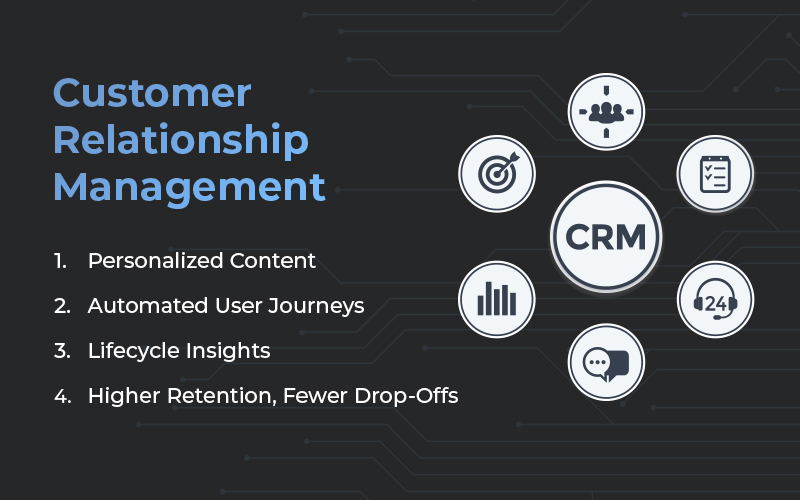
A Customer Relationship Management system plays a pivotal role in unifying first-party and zero-party data. It serves as the central hub where all customer interactions are recorded, analyzed, and activated for marketing purposes.
By integrating your CRM with a Marketing Cloud engagement tool, you can:
- Deliver hyper-personalized content
- Trigger automated journeys based on behavior
- Understand lifecycle stages more deeply
- Reduce churn and increase retention
Marketing Cloud Engagement and Automation
Modern marketing demands both personalization and scalability, and that’s where marketing cloud platforms like Salesforce Marketing Cloud play a crucial role. These platforms allow brands to harness first-party data in real time, delivering relevant messages across multiple touchpoints. This includes:
- Email marketing with tailored content based on user preferences or behavior
- SMS campaigns triggered by specific customer actions or timelines
- Social media advertising that aligns with a user’s previous interactions
- Web personalization, such as dynamic product recommendations or custom landing pages
With these tools, brands can automate complex, multichannel campaigns that feel highly personalized to each user. For example, if a customer browses a product but doesn’t purchase it, the platform can automatically trigger a follow-up email or SMS reminder, customized based on their browsing history.
What makes Marketing Cloud engagement especially powerful is its ability to balance automation with authenticity. Campaigns are data-driven and scalable, yet they don’t feel intrusive because they rely on first-party data, which is ethically collected through user interactions. This allows brands to respect user privacy while still delivering the right message at the right time.
In short, platforms like Salesforce Marketing Cloud help marketers do more with their data, turning insights into action and actions into lasting customer relationships.
Tactics and Tools for Ethical Customer Data Collection
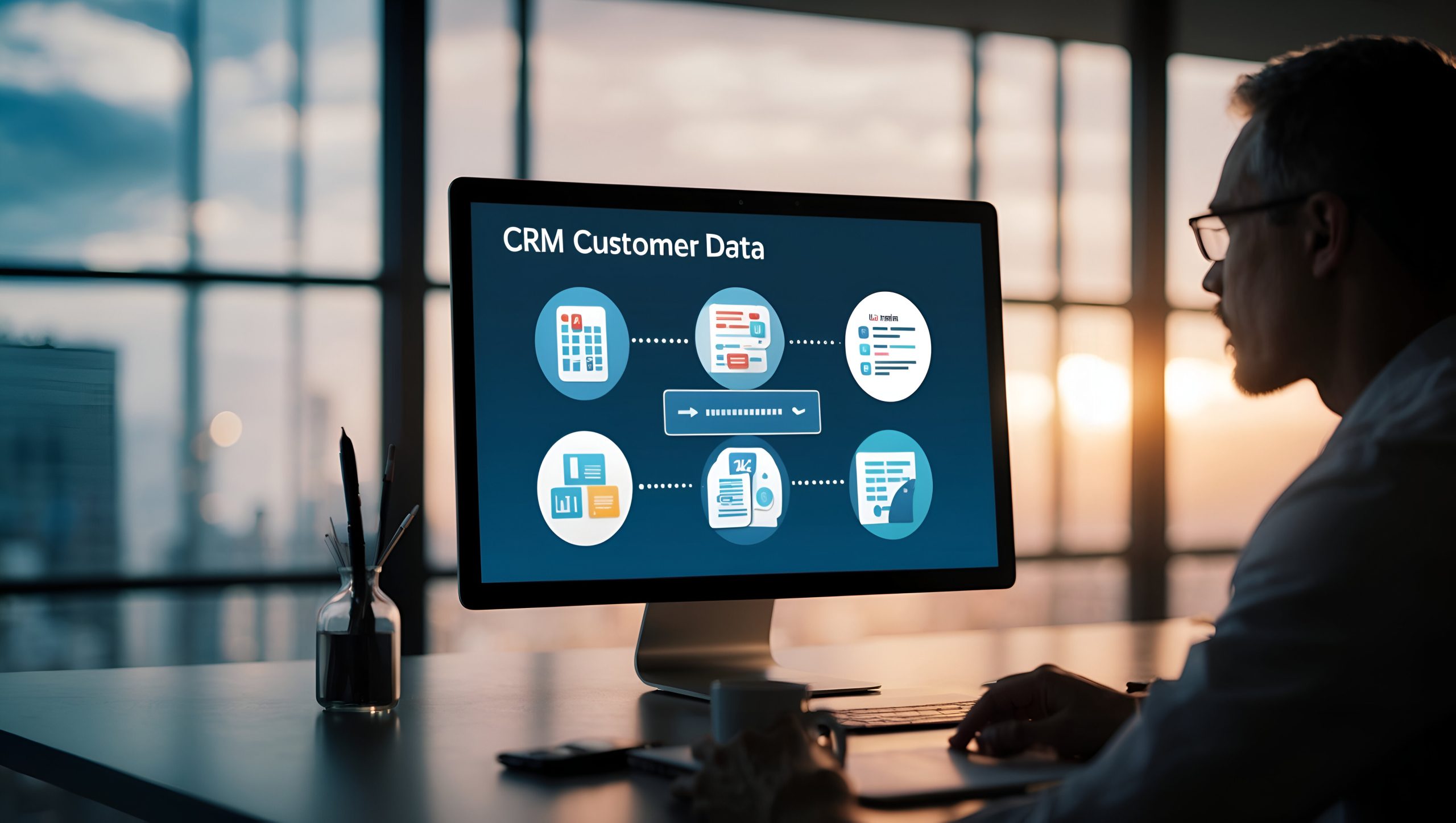
Your data strategy should include tools and tactics that align with your privacy-first principles. Here’s a shortlist:
Tactics:
- Use progressive profiling to avoid overwhelming users
- Make privacy policies accessible and understandable
- Offer incentives for data sharing (like discounts or content)
- Leverage surveys and feedback forms for zero party data
All tactics must comply with GDPR and CCPA to ensure ethical handling of user data.
Tools:
- Google Consent Mode
- OneTrust or TrustArc (CMPs)
- Salesforce CRM and Marketing Cloud
- Customer data platforms (CDPs)
- Form builders with consent fields (e.g., Typeform, Jotform)
Data-Driven Marketing Without Compromise
Data-driven marketing doesn’t have to come at the cost of user privacy. It can improve the client experience if done correctly. Marketers who use first-party and zero-party data responsibly can:
- Deliver content that users want
- Create more relevant and respectful journeys
- Build lasting relationships based on transparency
Data that is ethically sourced and intelligently applied performs better because it respects the user’s privacy and aligns with what they’ve explicitly or implicitly asked for.
Challenges in Privacy-First Marketing

(And How to Overcome Them)
1. Loss of Third-Party Tracking
With the phasing out of third-party cookies and stricter browser policies, marketers are losing traditional ways to track users across websites. This makes audience targeting and ad personalization more difficult.
Solution: Shift your focus to building first-party and zero-party data through owned channels like websites and email. Enrich these assets with real-time engagement data to fuel personalized experiences.
2. Compliance Complexity
Navigating privacy regulations like GDPR, CCPA, and others can be confusing and time-consuming. Non-compliance risks not only fines but also brand reputation.
Solution: Automate consent and data governance using Consent Management Platforms (CMPs). Regularly update your data practices to stay compliant as laws evolve.
3. Customer Reluctance to Share Data
In a privacy-first world, users are more cautious about sharing personal information. Without trust or perceived value, they may opt out or abandon interactions.
Solution: Communicate the value exchange, offer personalized experiences, loyalty rewards, or exclusive content in return for data. Make privacy policies transparent and user-friendly.
4. Measuring Success
As traditional tracking fades, so does the ability to rely on clicks, impressions, and other legacy metrics. Marketers need new ways to prove ROI and optimize performance.
Solution: Shift focus to privacy-safe metrics like email open rates, opt-in rates, retention, engagement levels, and Customer Lifetime Value (CLTV). These offer better insight into long-term relationships.
Real-World Examples of Privacy-First Brands
- Apple: Emphasizes device-level privacy and user control over data.
- Patagonia: Collects minimal data and leads with transparency.
- Starbucks: Uses zero-party data through its app & loyalty programs to personalize offers.
- Sephora: Allows users to tailor beauty preferences for highly personalized shopping.
These brands prove that you can drive growth while honoring privacy.
The Future of Marketing is Consent-Led and Customer-Centric
With every regulation, every browser update, and every privacy breach in the news, one thing becomes clear: the future of marketing is privacy-first. That means:
- Prioritizing customer data collection only when it’s ethical, relevant, and consent-based
- Embracing tools like Consent Management Platforms and CRM systems to centralize data
- Focusing on trust, value exchange, and personalization using first-party data
- Letting go of outdated third-party cookies and embracing a cookieless, customer-first strategy
Conclusion:
At Scrum Digital, we believe privacy-first marketing is not just a trend; it’s the new gold standard. Brands that embrace first-party data, respect consent, and build first-party data strategies aligned with GDPR compliance and CCPA compliance will not only avoid penalties, but they’ll win customer trust and loyalty.
As we navigate this transformative era in marketing, remember: the data you collect should serve the customer as much as it serves your business. Ethical data is powerful data. And in a world without third-party cookies, it’s your most valuable asset.
Frequently Asked Questions
Why is first-party data significant, and what does it mean?
First-party data is info collected directly from customers. Building trust requires marketing that is accurate and based on consent.
What distinguishes third-party data from first-party data?
First-party data is collected with your channels’ permission, but third-party data is less reliable and comes from other sources.
What distinguishes first-party data from zero-party data?
Customers’ purposeful sharing of information is known as zero-party data, whereas their actions are the basis for first-party data. Both enhance marketing that respects privacy.
How do Consent Management Platforms and CRM systems help privacy-first marketing?
Consent Management Platforms handle permissions and compliance. CRM systems organize data for ethical, personalized engagement.
Why is first-party data important in a cookieless world?
With third-party cookies disappearing, first-party data ensures better insights, privacy compliance, and targeted marketing.
